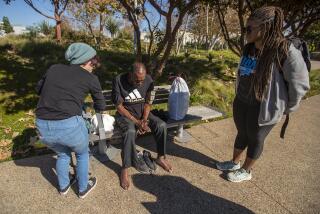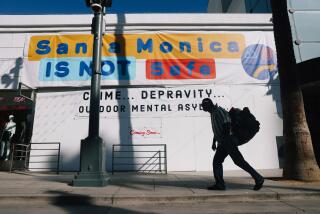Council OKs Curfew, 5-2, Amid Protest From Youths : Ordinance: Supporters say the measure, effective Sept. 1, will protect the community. Critics say it is open to abuse and harassment of minorities.
- Share via
SANTA MONICA — Manuel Lares remembers well the six months after he got his driver’s license. What he remembers are the countless encounters with Santa Monica police officers. They stopped him because he resembled a suspect in a robbery, because he had a broken light bulb on his tail light, because he had too many people in the car.
But the real reason he was pulled over, at least in Lares’ mind, is because he is a Latino and police harass minority youths.
That was the message delivered to the Santa Monica City Council by Lares, now 21, and other young men and women who poured out their pain and anger as they argued against a youth curfew that passed, 5 to 2, despite their pleas.
Council members and community groups supporting the curfew said it would protect teen-agers from harm late at night and protect the community from growing gang activity.
To those who spoke against it, the curfew sends a negative message to young people and provides police with a legal means to harass minority youth.
“It’s going to be used against people of color,” said Javier Gonzalez, 21. “You can say it’s not, but that’s just the way it goes down.”
*
Recalling his own experiences with police as an African-American teen-ager, Santa Monica Police Chief James T. Butts said he empathized with the speakers. But noting the two-day diversity training mandated for all officers, Butts vowed that the law would be enforced evenhandedly.
Still, Butts reminded everyone that police work entails stopping people for questioning: “Descriptions will be given. People will be stopped. There’s a gang problem in the city. . . . There are gang problems in the county. We are not an island. . . . We need a means of protecting youth.”
The vote on the curfew capped more than a year of impassioned debate and one previous council vote on the issue that ended in a tie, with one member absent.
The strength of the debate was surprising in one sense because Santa Monica had had a curfew law on the books for 45 years until former City Atty. Robert M. Myers issued an opinion that the law was too vaguely worded to pass constitutional muster.
A survey of other area cities revealed that virtually all of them have curfews. Although many of cities seldom enforce their laws, the local beach cities use them all the time.
A curfew law provides police with probable cause to approach teen-agers younger than 18. But the Santa Monica ordinance, which will go into effect Sept. 1, provides myriad exceptions to its provisions that teen-agers must be off the streets after 10 p.m. weeknights and 11 p.m. on Fridays and Saturdays.
For instance, teen-agers are permitted to attend movies, sporting events, run errands for their parents, work or be traveling to or from these activities. What is not allowed is hanging out on the streets or at the Pier or at the Third Street Promenade.
Teen-agers who are cited for curfew violations will be taken to the police station and released to their parents. They will not be arrested or put into a cell. After a year, the council will revisit the law to see how it is working and decide whether to extend it.
The city is also working on a plan to expand late-night recreational activities for teen-agers to offer an alternative to the street corner.
According to police statistics, 44% of arrests for juvenile crime in the year ending June 30 occurred during the proposed curfew hours. Of the 65 juvenile arrests for violent crime during that period, 42% of the arrests happened during curfew.
Merchants and property owners on the Promenade were among those who supported the curfew, saying groups of 15 teen-agers at midnight made other patrons fearful and often wound up being victims of themselves.
Tony Palermo, co-owner of Teaser’s restaurant and president of the area’s restaurant association, said parents could not expect to drop their teen-agers off for hours without supervision.
“Fourteen- and 15-year-olds should be doing something other than running in packs until 1 a.m.,” Palermo said.
Other groups that favored the curfew included Mid-City Neighbors, Save Our City, Concerned Homeowners of Santa Monica, the Santa Monica Republican Club and the local PTA council.
“Our children have all their lives to exercise their independence,” said Jan Ludwinski, speaking for the public safety-oriented group, Save Our City. “It’s our duty to do what’s good for them.”
The Mexican American Political Assn., the Santa Monica Commission on the Status of Women and state Sen. Tom Hayden (D-Santa Monica) opposed the curfew, as did many other individuals and Mayor Judy Abdo and Councilman Tony Vazquez.
Vazquez suggested that curfew proponents didn’t understand that not everyone in Santa Monica lived in mansions that afforded youths the space to comfortably socialize at home.
Vazquez also said he doubted that the others on the council, despite proclaiming their empathy, could truly understand the pain and suffering of minorities.
“How do we explain to someone who’s never experienced racism or discrimination that it exists?” Vazquez asked. “We should be designing programs (for youths), not regressive ordinances. . . . When are we going to stop passing these regressive ordinances that are not solving our problems?”
But Councilwoman Asha Greenberg said any law has the potential to be selectively enforced. “Does that mean we should not have police officers contacting citizens?” she asked. “Does that mean we should not have any laws?”
More to Read
Sign up for Essential California
The most important California stories and recommendations in your inbox every morning.
You may occasionally receive promotional content from the Los Angeles Times.












